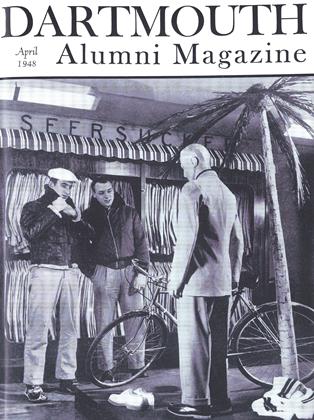by Francis E. Merrill '26. Harper & Brothers, 1948. 254 pp
The Committee on War Studies of the Social Science Research Council has sponsored a series of investigations by representative social scientists, specialists in various fields of economics, political science, and sociology. These investigations are directed at the measurement and evaluation of the impact of World War II upon American society. This volume by Professor Francis E. Merrill is one of the first to be published.
In modern war no individual or institution remains untouched. The range of social problems created or affected by total war is therefore extremely broad. Examining the central hypothesis "that World War II intensified, but did not substantially modify, the social problems of a peacetime society," Professor Merrill's analysis proceeds along two main lines. The major social changes wrought by war—such as shifts in occupation and employment, growth of war centers, and mobility of population—serve as a frame of reference for the analysis of specific problems. A carefully selected series of social problems are then investigated. They include desertion, divorce, emotional maladjustments of children, adolescent unsettlement, sexual promiscuity, prostitution, juvenile delinquency, crime, mental derangement, and suicide. Professor Merrill's analysis of statistical trends in each of these problems leads him to revise his original hypothesis and to conclude that the war "had a differential effect upon social problems, intensifying some, alleviating others, and creatting still others in a society made more dynamic by the pressures of total war."
As a study of social disorganization, this investigation is especially noteworthy for its development of the crucially important role of social values in relation to both the definition and amelioration of so.cial problems in American culture. Another outstanding feature is its establishment of a close causal relationship between war-time mobility of population and the intensification of such social problems as divorce and juvenile delinquency. Finally, Professor Merrill's analysis reveals striking variations in the acceleration of war-time social change. Technological change, culminating in the control of atomic energy, took place at the most rapid rate in history. Changes in social institutions, attitudes and values were much slower. The end result was a steadily widening gap between technology and institutions that constitutes "perhaps the most significant cultural lag that has yet existed."
 View Full Issue
View Full Issue
More From This Issue
-
 Article
ArticleStumps and Scholarships
April 1948 By ROBERT S. MONAHAN '29 -
 Class Notes
Class Notes1942
April 1948 By JAMES L. FARLEY, JOHN H. HARRIMAN, ADDISON L. WINSHIP II -
 Class Notes
Class Notes1897
April 1948 By WILLIAM H. HAM, WELD A. ROLLINS, MORTON C. TUTTLE -
 Class Notes
Class Notes1918
April 1948 By ERNEST H. EARLEY, DONALD L. BARR, DAVID L. GARRATT -
 Class Notes
Class Notes1931
April 1948 By A. W. LAUGHTON, WILLIAM H. SCHULDENFREI, ERNEST H. MOORE -
 Class Notes
Class Notes1919
April 1948 By J. K. HUNTINGTON, MAX A. NORTON, ROSCOE .A. HAYES







